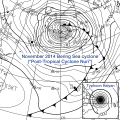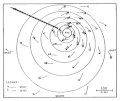Portal:Tropical cyclones
The Tropical Cyclones Portal
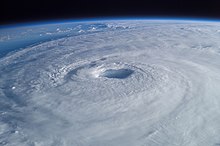
A tropical cyclone is a storm system characterized by a large low-pressure center, a closed low-level circulation and a spiral arrangement of numerous thunderstorms that produce strong winds and heavy rainfall. Tropical cyclones feed on the heat released when moist air rises, resulting in condensation of water vapor contained in the moist air. They are fueled by a different heat mechanism than other cyclonic windstorms such as Nor'easters, European windstorms and polar lows, leading to their classification as "warm core" storm systems. Most tropical cyclones originate in the doldrums, approximately ten degrees from the Equator.
The term "tropical" refers to both the geographic origin of these systems, which form almost exclusively in tropical regions of the globe, as well as to their formation in maritime tropical air masses. The term "cyclone" refers to such storms' cyclonic nature, with anticlockwise rotation in the Northern Hemisphere and clockwise rotation in the Southern Hemisphere. Depending on its location and intensity, a tropical cyclone may be referred to by names such as "hurricane", "typhoon", "tropical storm", "cyclonic storm", "tropical depression" or simply "cyclone".
Types of cyclone: 1. A "Typhoon" is a tropical cyclone located in the North-west Pacific Ocean which has the most cyclonic activity and storms occur year-round. 2. A "Hurricane" is also a tropical cyclone located at the North Atlantic Ocean or North-east Pacific Ocean which have an average storm activity and storms typically form between May 15 and November 30. 3. A "Cyclone" is a tropical cyclone that occurs in the South Pacific and Indian Oceans.
Selected named cyclone -
Typhoon Wayne, known in the Philippines as Typhoon Miding, is one of the longest-lived tropical cyclones on record in the north-western Pacific Ocean. The system meandered for 21 days in August–September 1986 between the South China Sea and far western tropical North Pacific Ocean, staying within the monsoon trough and causing heavy rains across the Philippines, Taiwan, southeast China, Hainan Island, and Vietnam. Its maximum sustained winds peaked at category two strength on the Saffir–Simpson scale. Various signals were raised for Hong Kong three times due to Wayne's unusual track. A total of 490 perished, and the storm caused US$399 million (1986 US dollars) in damage. (Full article...)
Selected article -

A storm surge, storm flood, tidal surge, or storm tide is a coastal flood or tsunami-like phenomenon of rising water commonly associated with low-pressure weather systems, such as cyclones. It is measured as the rise in water level above the normal tidal level, and does not include waves.
The main meteorological factor contributing to a storm surge is high-speed wind pushing water towards the coast over a long fetch. Other factors affecting storm surge severity include the shallowness and orientation of the water body in the storm path, the timing of tides, and the atmospheric pressure drop due to the storm. (Full article...)
Selected image -
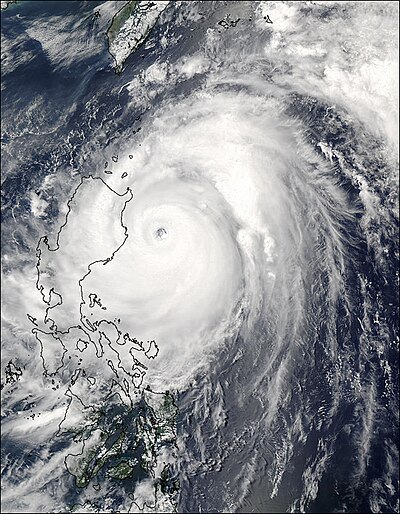
Selected season -

The 2003 Pacific hurricane season was the first season to feature no major hurricanes (storms of Category 3 intensity or higher on the Saffir–Simpson hurricane wind scale) since 1977. The season officially began on May 15, 2003 in the Eastern North Pacific (east of 140°W), and on June 1 in the Central (between 140°W and the International Date Line); both ended on November 30. These dates, adopted by convention, historically describe the period in each year when most tropical cyclogenesis occurs in these regions of the Pacific. The season featured 16 tropical storms, 7 of which intensified into hurricanes, which was then considered an average season. Damage across the basin reached US$129 million, and 23 people were killed by the storms.
Despite the overall lack of activity, the season produced an unusually large number of tropical cyclones that affected Mexico, with eight tropical cyclones making landfall on either side of Mexico, which was the second highest on record. Tropical Storm Carlos struck Oaxaca in late June, resulting in nine fatalities. In late August, Hurricane Ignacio struck the Baja California Peninsula, killing four people and inflicting US$21 million in damage. In September, Hurricane Marty affected the same areas as Ignacio, and was responsible for 12 casualties and US$100 million in damage, making Marty the costliest and deadliest storm of the season. In October, Hurricanes Olaf and Nora struck western Mexico as tropical depressions, causing slight damage and one casualty. (Full article...)
Related portals
Currently active tropical cyclones

Italicized basins are unofficial.
- North Atlantic (2025)
- No active systems
- East and Central Pacific (2025)
- No active systems
- West Pacific (2025)
- No active systems
- North Indian Ocean (2025)
- No active systems
- Mediterranean (2024–25)
- No active systems
- South-West Indian Ocean (2024–25)
- No active systems
- Australian region (2024–25)
- Tropical Low 7U
- South Pacific (2024–25)
- No active systems
- South Atlantic (2024–25)
- No active systems
Last updated: 21:38, 28 December 2024 (UTC)
Tropical cyclone anniversaries
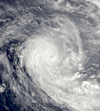
January 1
- 1990 - Cyclone Alibera, one of the longest-lasting storms on record in the south-west Indian Ocean, struck southeastern Madagascar, killing 46 people and causing the heaviest damage in Mananjary since 1925.
- 1993 - Cyclone Kina (pictured) moved through Fiji, causing $F170 million ($US110 million) in damage and becoming the most damaging in the nation.
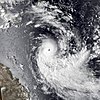
January 2
- 1994 - Cyclone Rewa (pictured) reached its peak intensity east of Australia during its 28 day trek.
- 2014 - Cyclone Bejisa passed near Réunion island in the south-west Indian Ocean, causing one death and heavy agriculture damage.

January 3
- 2000 - Typhoon Soulik (pictured) reached peak intensity as a Category 3 typhoon in the Philippine Sea. It was one of the few West Pacific storms to span two calendar years.
- 2021 - The remnant low of Cyclone Chalane, which developed over the South-West Indian Ocean basin, emerged into the South Atlantic waters after crossing the African continent.
Did you know…
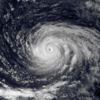



- …that the Joint Typhoon Warning Center considers that Typhoon Vera (pictured) of 1986 is actually two distinct systems, formed from two separated low-level circulations?
- …that Cyclone Freddy (track pictured) in 2023 was the longest-lasting tropical cyclone recorded?
- …that the typhoons of 2024—Yinxing, Toraji, Usagi, and Man-yi (pictured)—made history as the first recorded instance since 1951 of four tropical cyclones coexisting in November?
- …that Hurricane Otis (pictured) in 2023 was the first Pacific hurricane to make landfall at Category 5 intensity and surpassed Hurricane Patricia as the strongest landfalling Pacific hurricane on record?
General images -

The 1972 Atlantic hurricane season was a cycle of the annual tropical cyclone season in the Atlantic Ocean in the Northern Hemisphere. It was a significantly below average season, having only four fully tropical named storms, the fewest since 1930. It was one of only five Atlantic hurricane seasons since 1944 to have no major hurricanes, the others being 1968, 1986, 1994, and 2013. The season officially began on June 1, 1972 and ended on November 30, 1972. These dates, adopted by convention, historically describe the period in each year when most tropical systems form. However, storm formation is possible at any time of the year, as demonstrated in 1972 by the formation of Subtropical Storm Alpha on May 23. The season's final storm, Subtropical Storm Delta, dissipated on November 7.
The season produced nineteen tropical or subtropical cyclones, of which seven intensified into tropical or subtropical storms; three became hurricanes, of which only but only one, Betty, had sustained winds greater than minimum hurricane force. Despite its relative inactivity, the 1972 season resulted in one of the worst natural disasters in American history, Hurricane Agnes. Agnes was a weak but large storm that initially made landfall on the Florida Panhandle before moving up the eastern United States. The hurricane killed 122 people and caused $2.1 billion (1972 USD) in damage, mostly due to flooding in Pennsylvania and New York. (Full article...)
Topics
Subcategories
Related WikiProjects
WikiProject Tropical cyclones is the central point of coordination for Wikipedia's coverage of tropical cyclones. Feel free to help!
WikiProject Weather is the main center point of coordination for Wikipedia's coverage of meteorology in general, and the parent project of WikiProject Tropical cyclones. Three other branches of WikiProject Weather in particular share significant overlaps with WikiProject Tropical cyclones:
- The Non-tropical storms task force coordinates most of Wikipedia's coverage on extratropical cyclones, which tropical cyclones often transition into near the end of their lifespan.
- The Floods task force takes on the scope of flooding events all over the world, with rainfall from tropical cyclones a significant factor in many of them.
- WikiProject Severe weather documents the effects of extreme weather such as tornadoes, which landfalling tropical cyclones can produce.
Things you can do
 |
Here are some tasks awaiting attention:
|
Wikimedia
The following Wikimedia Foundation sister projects provide more on this subject:
-
Commons
Free media repository -
Wikibooks
Free textbooks and manuals -
Wikidata
Free knowledge base -
Wikinews
Free-content news -
Wikiquote
Collection of quotations -
Wikisource
Free-content library -
Wikiversity
Free learning tools -
Wikivoyage
Free travel guide -
Wiktionary
Dictionary and thesaurus



